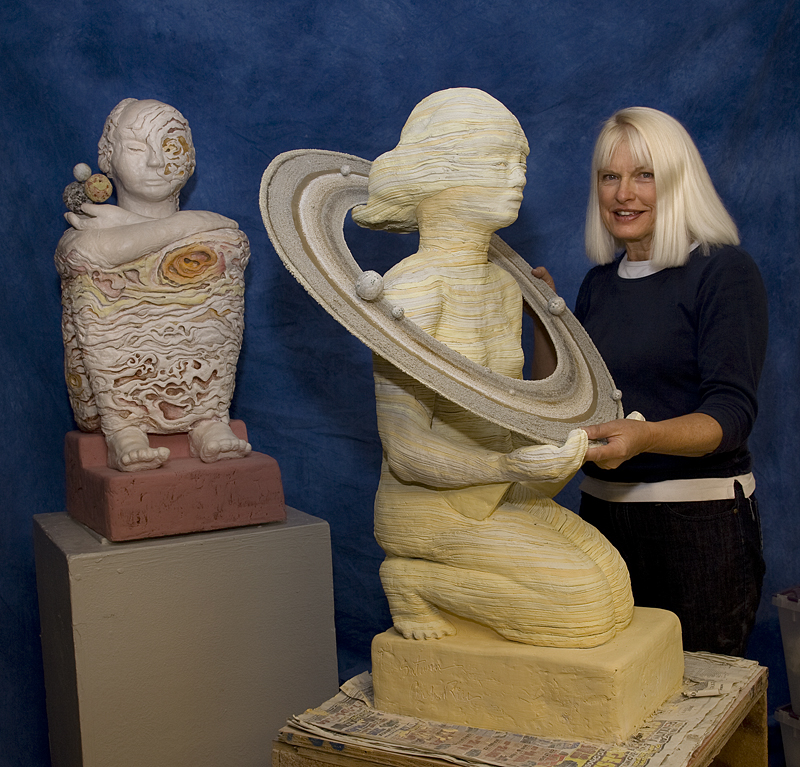When artist Paula Rice peers through telescopes at the night sky, she not only observes the cosmos, she finds herself.
Rice, a Northern Arizona University art professor, recently completed “The Planets,” figurative interpretations of the planets around the sun. It features nine clay sculptures inspired by Rice’s lifelong love for astronomy and images captured by the Hubble Telescope.
“Creating these sculptures was a way for me to go to the planets without the physical trip, and to meet myself when I get there.” Rice said. “We are made of star stuff. We are billion-year-old carbon ourselves.”
In honor of the International Year of Astronomy, “The Planets” will be on display in the historic Rotunda Museum at Lowell Observatoryfrom Aug. 5 to Sept.19, with a public opening reception with the artist beginning at 6 p.m. today, Aug. 5.
Rice’s humanlike planets not only set out to capture her experience of the universe as “loving, intelligent and harmonious,” they also incorporate the empirical evidence of planet surfaces provided through photos from the Hubble Telescope.
“My new work is a way for me to imagine a reality incomprehensively vast and bring it down to human size,” Rice explained. “The series is about us here on Earth. For the first time in human history, our sense of place and the size of our imaginations have to stretch to include new information about these worlds.”
She said each ceramic planet features new landscape and surface information from the space photography.
“To some degree their very postures relate astronomically to what we know about the planets,” Rice said. “For example, the figure Mars is positioned drinking water out of its hand. Uranus has an accurate pea green and bluish glaze for its gaseous nature, and I made Venus to be inhospitably hot, with red searing eyes and lava flowing from the figure onto the pedestal.”
Venus also incorporates the art history associated with the mythical goddess. She sits looking seductively over her shoulder. Jupiter balances its moon in its fingertips. Saturn looks meditative, cradling its fiberglass-crafted rings in the palm of its hands. Neptune features white clouds over a bright blue glaze. Mercury and Pluto are childlike.
“Not including Pluto was never an option,” said Rice, who has lived in Flagstaff for 22 years and is a regular visitor to Lowell Observatory, where the “demoted” planet originally was discovered.
The Earth, covered in swirly clouds, sits with its legs crossed and hands resting in its lap as a gold dolphin dives into its ocean center.
Rice said she began the project with the planet Earth after a series of northern Arizona wildfires broke out about four years ago sparking her interest in the tumultuous beauty of fire.
To create the planets, Rice used various types of clay, glazes and kiln firing techniques. They weigh from about 20 to 80 pounds.
“After trying to paint fire on canvas, I said forget that, I am going to treat the surface of my figures like the surface of the Earth and put fire there among clay canyons, rocks and river beds,” she said. “I think of our bodies as our home planet, so it wasn’t that much of a leap to look out at the other planets and use the human body as a representation of them.”
She said the ceramic planets, each built on a sturdy ceramic base, also are influenced compositionally by the frontal nature and sense of stillness of ancient Egyptian figurative sculpture, “a sensibility that seems appropriate to planets when I look out at them through telescope,” she added.
Rice has been studying night skies for years and once belonged to four astronomy clubs simultaneously.
She said her love for the mystery and beauty of the universe was the ultimate inspiration for “The Planets,” which was unveiled during a juried international venue in conjunction with the National Council in Education for the Ceramics Arts Conference in Phoenix last April.
View the complete collection online.



